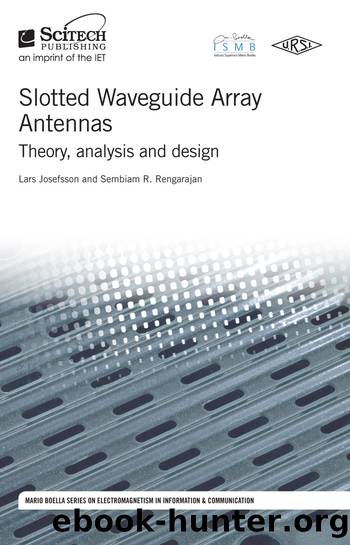Slotted Waveguide Array Antennas by Lars Josefsson;Sembiam R. Rengarajan;

Author:Lars Josefsson;Sembiam R. Rengarajan; [Неизв.]
Language: eng
Format: epub
ISBN: 9781785611407
Publisher: Institution of Engineering & Technology
Published: 2018-05-20T21:00:00+00:00
where [b] is a column matrix containing the TE10 mode wave amplitudes leaving the slot from each of the four ports while [a] contains the corresponding quantities of the waves incident at the slot. The normalised series impedance in the main line is given by (8.7).
where and are the normalised impedances seen by the slot at ports 3 and 4, respectively. The bars on top imply normalised impedances whereas the un-normalised impedances are denoted without bars. Characteristics of this type of coupler have been analysed by the moment method solutions to the coupled integral equations for the electric fields of apertures of a thick slot [1].
Resonant coupling slots are employed in planar standing wave arrays to realise the aperture distribution with uniform phase. Data on the resonant length and |S 11| at resonance for a range of tilt angles, generated by a computational electromagnetics (CEM) code are needed in such designs. The variation of the resonant length with the tilt angle of the slot is not significant for standard height waveguides whereas for reduced height waveguides it is not negligible.
Figure 8.4 shows a circuit model for a non-resonant seriesâseries slot [2]. The transformer ratio n, the inductance L and the capacitance C needed to provide the susceptance in the main waveguide are functions of frequency. A simplified model has been proposed by Mazzarella and Montisci [2]. In that model, the transformer ratio n is determined at the resonant frequency. Over a frequency range of 6.6% below the resonant frequency L = L 1 and C = C 1 were found to produce accurate values of the susceptance. Similarly L = L 2 and C = C 2 yielded accurate susceptances over a 6.6% frequency band above resonance. By choosing the values of L and C between the two sets they were able to produce an accurate model over a 10% frequency band [2]. The value of n at resonance is the coupling coefficient Ï defined in (8.5).
Download
This site does not store any files on its server. We only index and link to content provided by other sites. Please contact the content providers to delete copyright contents if any and email us, we'll remove relevant links or contents immediately.
| Automotive | Engineering |
| Transportation |
Whiskies Galore by Ian Buxton(41524)
Introduction to Aircraft Design (Cambridge Aerospace Series) by John P. Fielding(32881)
Small Unmanned Fixed-wing Aircraft Design by Andrew J. Keane Andras Sobester James P. Scanlan & András Sóbester & James P. Scanlan(32567)
Craft Beer for the Homebrewer by Michael Agnew(17926)
Turbulence by E. J. Noyes(7690)
The Complete Stick Figure Physics Tutorials by Allen Sarah(7134)
Kaplan MCAT General Chemistry Review by Kaplan(6584)
The Thirst by Nesbo Jo(6432)
Bad Blood by John Carreyrou(6270)
Modelling of Convective Heat and Mass Transfer in Rotating Flows by Igor V. Shevchuk(6218)
Learning SQL by Alan Beaulieu(6023)
Weapons of Math Destruction by Cathy O'Neil(5819)
Man-made Catastrophes and Risk Information Concealment by Dmitry Chernov & Didier Sornette(5638)
Digital Minimalism by Cal Newport;(5383)
Life 3.0: Being Human in the Age of Artificial Intelligence by Tegmark Max(5181)
iGen by Jean M. Twenge(5149)
Secrets of Antigravity Propulsion: Tesla, UFOs, and Classified Aerospace Technology by Ph.D. Paul A. Laviolette(4973)
Design of Trajectory Optimization Approach for Space Maneuver Vehicle Skip Entry Problems by Runqi Chai & Al Savvaris & Antonios Tsourdos & Senchun Chai(4837)
Electronic Devices & Circuits by Jacob Millman & Christos C. Halkias(4739)
